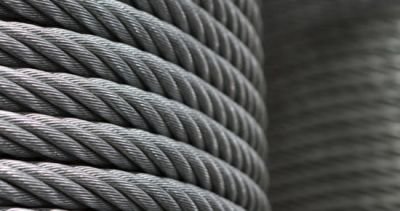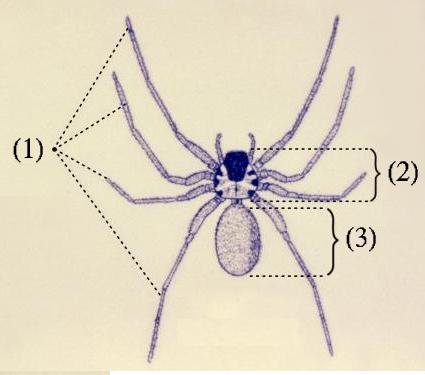
Wire rope stainless steel image source
Greetings, how are you steemit friends? Glad to meet you again and hopefully healthy always. Today I am still going to discuss natural engineers, if previously we have laid out termites as builders of skyscrapers and beaver as dam makers, then today we will discuss spiders.
As we know that the spider is a carnivore whose majority build its nest with a net, the spider also has a toxin that serves to weaken its targets.
So, what makes spiders classified as natural engineers?
The spider is an animal that has two body segments and does not live in water, the spider is a close relative to the scorpion and the eight-legged [1].
Spiders can live in almost every region of the world, due to the carnivorous nature of spiders that prey on insects, but there are also types of spiders that have cannibal character.
Unlike most insects that have three body segments, the spider actually has two segments of the body known as a cephalothorax (front) and opisthosoma (back), a segment of opisthosoma is more precisely called an area of a stomach and cephalothorax better known as a head and foot- legs attached [1].

1-Legs 2-cephalothorax 3-opisthosoma image source
Most spiders build their nest/orb nets from yarn or fibers, the yarn is composed of very thin protein fibers [1]. Actually, the nest is more properly called a catcher prey.
The net is produced by a spider through a gland located in the opisthosoma segment, the gland is produced through a combination with a very high compatibility, so it can produce very strong thin yarns/fibers.
The fiber or yarn is spun by the spider in such a way that it forms a net complete with an adhesive that functions so that a prey is not released as it enters a trap, uniquely, the spider has never been exposed to its own trap adhesive.
As I mentioned above, that yarn is produced from a cauldron that is uniquely combined by the spider and not all threads are used to build traps or have adhesives.
Actually, spiders are considered to have a very complex yarn/fiber production system, they will pump some glands to get the yarn and will close it (stop pumping) if not needed. So it can be said they can produce threads when needed.
The liquid crystals in the form of parallel lines are formed by the thickening of substances pumped by the yarn-producing glands, the production of such thin crystalline proteins is reshaped to have amino acid chains that make elastic threads [2].
The matrix structure of a spider yarn including a composite material causes a yarn/fiber to have excellent strength, as we know that a thread will break if it reaches the critical point, the conventional fibers will be far apart and crack so that the fibers will be a very easily break.

orb webs contaminated by air humidity. image source
Unlike the yarn/fibers produced by a spider, when threads are done, a spider will then give the yarn layer with a certain liquid, a liquid can reduce and crack a yarn so that a critical point of cracking can be increased [2].
Spider yarn/fiber has a unique structure, the yarn has two interlocking layers of a core layer and adhesive layer, adhesive layer composed of 80% water [2].
When in the open area, a spider thread will be contaminated by moist air and melt an adhesive layer so it looks like a grain of water, the process causing a stretched thread. When a process occurs repeatedly the yarn core will continue to adjust its condition so that a yarn core will always be straight [2].
Scientists have also found that a spider will acidify a yarn formation in order for a yarn to become hard/strong [3].
The results also say that a spider yarn is five times stronger than steel fibers of the same thickness as we currently use, calculations suggest that spider threads have 150,000 Kg/m2 [3].
The fact is [3].
- Before building the nest, spiders first conceptualize a trap using very strong threads and even able to catch the plane.
- It takes 200 rolls of yarn per minute to produce an orb webs/trap capable of moving.
- Spider orb nets are formed from three main mesh structures.
- Female spiders have a size larger than the opposite sex and have a longer life.
- Spiders will not attack humans unless they feel threatened.
Currently, a Japanese company has created synthetic spider-producing technology that serves as a woven fabric/textile, the clothing that is claimed three times stronger than bulletproof vests (kevlar) [4].
Nature has provided various types of highly beneficial and environmentally friendly technologies, such as spiders that are now known to be stronger than conventional steel fibers.
The threads/fibers are produced by spider through several protein glands present in an opisthosoma segment with a unique elaborate process. A thread has different functions and as needed.
The results show that spider yarn/fibers have excellent strength compared to conventional steel fibers of the same diameter, even spider threads can be woven(textile) to produce a better outfit of bulletproof vests.
Keep in mind that spiders do not study chemistry, physics and other knowledge formally as humans do, but they know it naturally or instinctively.
Currently, scientists are still researching so that the future is expected this technology is getting better.
BAHASA
Salam, apa kabar teman steemit? Senang berjumpa kembali dengan anda dan semoga sehat selalu. Hari ini saya masih akan berdiskusi tentang para insinyur alam, jika sebelumnya kita telah mengenala rayap sebagai pembangun gedung pencakar langit dan beaver sebagai pembuat bendungan, maka hari ini kita akan membahas tentang laba-laba.
Seperti yang kita ketahui bahwa laba-laba merupakan karnivora yang mayoritas membangun sarangnya dengan jaring, laba-laba juga memiliki racun yang berfungsi untuk melemahkan mangsanya.
Jadi, apa yang menjadikan laba-laba tergolong sebagai insinyur alam?
Sebaiknya kita mengenal lebih dekat dengan hewan ini.
Laba-laba merupakan hewan yang memiliki dua segmen tubuh dan tidak hidup di air. laba-laba merupakan kerabat dekat dengan kalajengking dan berkaki delapan [1].
Laba-laba dapat hidup di hampir setiap daerah di bumi, hal tersebut disebabkan sifat karnivora laba-laba yang memangsa serangga, tetapi ada juga jenis laba-laba yang memiliki sifat kanibal.
Tidak seperti kebanyakan serangga yang memiliki tiga segmen tubuh, laba-laba justru memiliki dua segmen tubuh yang dikenal dengan cephalothorax (bagian depan) dan opisthosoma ( bagian belakang), segmen opisthosoma lebih tepatnya disebut bidang perut dan cephalothorax lebih dikenal dengan kepala dan tempat kaki-kaki melekat [1].
Kebanyakan laba-laba membangun sarangnya dari benang, benang tersebut tersusun dari serat protein yang sangat tipis [1].. Sebenarnya sarang tersebut lebih tepat disebut jaring penangkap mangsa.
Jaring tersebut diproduksi oleh laba-laba melalui kelenjar yang terdapat di segmen opisthosoma, kelenjar diproduksi melalui kombinasi dengan keserasian yang sangat tinggi, sehingga dapat menghasilkan benang tipis yang sangat kuat.
Benang-benang dipintal oleh laba-laba dengan sedemikan rupa dan berbentuk jaring lengkap dengan perekat yang berfungsi agar mangsa tidak terlepas saat masuk perangkap, uniknya, laba-laba tidak pernah terkena perekat atau perangkapnya sendiri.
Seperti yang telah saya sebutkan diatas, bahwa benang dihasilkan dari kelejar yang dikombinasikan secara unik oleh laba-laba dan tidak semua benang dimanfaatkan untuk membangun perangkap atau memiliki perekat.
Sebenarnya laba-laba dianggap memiliki sebuah sistem produksi benang modern yang sangat kompleks, mereka akan memompa beberapa kelenjar untuk mendapatkan benang dan akan menutupnya (berhenti memompa) jika tidak dibutuhkan. Sehingga dapat dikatakan mereka dapat menghasilkan benang saat dibutuhkan.
Kristal cair yang berbentuk garis sejajar terbentuk oleh pengentalan zat yang dipompa oleh kelenjar penghasil benang, hasil produksi protein berupa kristal tipis tersebut dibentuk kembali agar memiliki rantai-rantai asam amino yang mejadikan benang elastis [2].
Struksur matriks benang laba-laba yang termasuk bahan komposit menyebabkannya memiliki kekuatan yang sangat baik, seperti yang kita ketahui bahwa sebuah benang akan putus jika sampai pada titik kritis, serat-serat konvensional akan saling berjauhan dan retak sehingga serat akan sangat mudah putus.
Berbeda dengan benang yang dihasilkan oleh laba-laba, saat benang-benang selesai dikerjakan, laba-laba kemudian akan melapisi benang tersebut dengan cairan tertentu, cairan tersebut dapat mengurangi dan keretakan benang sehingga titik kritis dapat ditingkatkan [2].
Benang laba-laba memiliki struktur yang unik, benang tersebut memiliki dua lapisan yang saling mengisi yaitu lapisan benang dan lapisan perekat, lapisan perekat tersusun dari 80% air [2].
Saat berada diarea terbuka, benang laba-laba akan terkontaminasi oleh udara yang lembab dan mencairkan lapisan perekat sehingga terlihat seperti butiran air, proses tersebut menyebabkan benang tertarik tegang. Ketika proses tersebut terjadi berulang maka inti benang akan terus menyesuaikan kondisi tersebut sehingga inti benang akan selalu lurus [2].
Para ilmuan juga menemukan bahwa laba-laba akan mengasamkan hasil pembentukan benang agar benang-benang tersebut menjadi keras [3].
Hasil penelitian juga menyebutkan bahwa benang laba-laba lima kali lebih kuat dibanding serat baja dengan ketebalan yang sama seperti yang saat ini sering kita gunakan, hasil perhitungan menyatakan bahwa benang laba-laba memiliki keteganan 150.000 Kg/m2 [3].
Faktanya [3].
- Sebelum membangun sarang, laba-laba terlebih dahulu mengkonsep sebuah perangkap menggunakan benang yang sangat kuat dan mampu menangkap pesawat.
- Dibutuhkan 200 gulungan benang per menit untuk menghasilkan sarang yang mampu bergerak.
- Sarang laba-laba dibentuk dari tiga struktur jaring utama.
- Laba-laba betina memiliki ukuran lebih besar dari lawan jenisnya dan memiliki umur yang lebih panjang.
- Laba-laba tidak akan menyerang manusia kecuali meresa terancam
Saat ini sebuah perusahaan Jepang telah menciptakan teknologi penghasil benang laba-laba sintetis yang berfungsi sebagai bahan tenunan pakaian, pakaian yang dimaksud diklaim tiga kali lebih kuat dari rompi anti peluru (kevlar) [4].
Alam telah menyediakan berbagai jenis teknologi yang sangat bermanfaat dan ramah lingkungan, seperti benang laba-laba yang saat ini diketahui lebih kuat dari serat baja konvensional.
Benang-benang tersebut diproduksi oleh laba-laba melalui beberapa kelenjar protein yang terdapat di segmen opisthosoma dengan proses rumit yang sangat unik. Benang tersebut memiliki fungsi berbeda dan sesuai kebutuhan.
Hasil penelitian menyebutkan, benang laba-laba memiliki kekuatan yang sangat baik dibanding serat baja konvensional dengan diameter yang sama, bahkan benang laba-laba dapat ditenun untuk menghasilkan pakaian yang lebih baik dari rompi anti peluru.
Perlu diingat bahwa laba-laba tidak mempelajari kimia, fisika dan pengetahuan lainnya secara formal seperti yang manusia lakukan, tetapi mereka mengetahui hal tersebut secara alamiah atau secara insting.
Saat ini para ilmuan masih terus meneliti sehingga kedepan diharapkan teknologi ini semakin baik.
This is the only thing I can write on this occasion, over all the mistakes and lack of unintentional writing as a servant of God, I apologize.
Thanks to friends who have visited this blog and provided constructive comments, as well as scientists who are willing to sacrifice their time for a better civilization.
Active link reference:
[1]www.wikipedia.org
[2]www.seranggakita.wordpress.com
[3]www.teknologi.inilah.com
[4]www.techno.okezone.com
Do you love science? by respecting the work of others and not plagiarism then you are welcome to join steemSTEM by using #science tags, you can also chat with us in steemit chat/steemSTEM channel.

Ayo dukung penulis STEM (Science, Technology, Engineering, Mathematics) Indonesia dengan menggunakan bahasa Indonesia dan #indo-STEM serta bergabung di discord https://discord.gg/KWesRm6
BEST REGARDS @kharrazi
Yup
Hopefully the real spiderman can save the world :D
awesome post great knowledge about natural technology . Upvoted please visit my blog as well
u have more knowledge its good info.. for us thanks for sharing